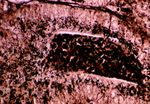Porcine Adenomatosis Complex
Jump to navigation
Jump to search
Synonyms
Porcine intestinal adenomatosis
Characteristic proliferation of mucosa.
Clinical
- Really only seen in the pig.
- Can affect all ages of pig.
- Clinical signs are variable.
- Anything from poor weight gain to diarrhoea, weight loss, cachexia and death.
- Seen often as problem in closed, low infection herds.
- Not seen in pigs with lots of other pathogens in guts.
Pathogenesis
- Caused by Lawsonia intracellularis.
- A spirochete that does not grow well except in tissue culture.
Pathology
- The terminal small intestine and colon are affected by proliferation of the mucosal epithelium.
- Gross
- Thickened mucosal epithelium.
- Has almost polypoid-like nodules several millimetres in diameter.
- Undifferentiated epithelium replaces goblet cells.
- Appears almost neoplastic.
- Histologically
- Porcine adenomatosis complex can be divided into four distinct syndromes:
- Intestinal adenomatosis
- THe basic hyperplastic and metaplastic changes are seen in the epithelium.
- Causes chronic weight loss and diarrhoea.
- Necrotic enteritis
- Terminal ileitis
- Characterised by marked hypertrophic thickening of the muscular portion of the wall of the terminal ileum.
- Gives an attendant stenosis of the lumen of the ileum.
- There is associated thickening of the mucosa due to hypertrophy and secondary granulomatous inflammation.
- This is presumably caused by a degree of obstruction to the passage of ingesta along the bowel caused by the mucosal hypertrophy.
- Appears very similar to Johnes disease
- Lots of mononuclear cells and a chronic granulomatous type of inflammation.
- Proliferative haemorrhagic syndrome.
- The bowel shows proliferation but with ulceration and copious haemorrhage into the bowel lumen.
- Animals are often be found dead.
- The pathogenesis is unclear.
- May involve a type of hypersensitivity reaction or secondary infection of some type.
- Intestinal adenomatosis
Sequelae
- Resolution.
- Necrotic enteritis.
- Secondary chronic infection (regional enteritis).
- Porcine haemorrhgaic enteritis (PHE).
